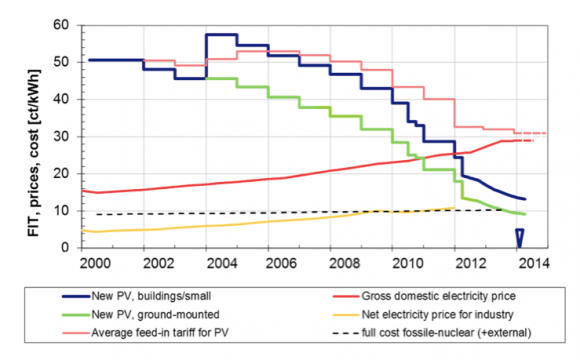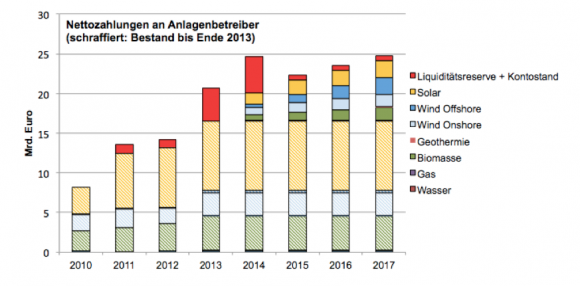The world’s solar leader grapples with how to make its solar policies financially sustainable.
As the German government gets ready for a major overhaul of its landmark renewable energy act, the fundamental problem is cost.
The Erneuerbare-Energien-Gesetz, or EEG law, set up the country’s system of feed-in tariffs (FITs) and mandatory purchases for independent renewable energy producers. This system has been highly successful, driving down solar costs and prices around the world. It has reduced emissions, diversified the power supply, reduced fuel imports, created jobs and driven down wholesale market prices.
But it has come at a high cost, which is explained by basic economics: total cost = P x Q.
These three simple graphs describe the price (P), the quantity (Q), and the resulting bill that German policymakers are now grappling with.
Graph 1: Price

Source: Fraunhofer Institute
With FITs, regulators look at the cost of new renewables and set a price tailored to each technology and size of project, plus a reasonable profit. On the theory that deployment would drive the technologies down the cost curve, regulators set up a regular “degression” of FIT prices, resetting prices annually.
FITs for solar started out at high levels in the early 2000s, and saw a steady decline as deployment costs came down. But cost declines began to outpace the ability of regulators to lower the FIT rates, causing a PV explosion. In 2010, regulators started to review FIT rates more frequently. By 2013, they were doing it monthly.
Graph 2: Quantity

Source: Zentrum für Sonnenenergie und Wasserstoff (ZSW)
Solar started growing rapidly in 2009 and exploded over the next three years, with 7 gigawatts per year added to an 80-gigawatt German power system. At the end of 2013, there were 1.4 million solar installations providing 35.7 gigawatts of capacity — more than any other power source — though only 5.8 percent of energy. Solar installations fell by half in 2013, as regulators clamped down on deployment
Graph 3: The bill

Source: Agora Energiewende
While regulators cut the FIT price by half between 2010 and 2012, the huge amount of solar built blew up the EEG-Umlage, the surcharge customers pay to cover the above-market costs of the FIT. It doubled between 2010 and 2013.
The third graph, taken from a new online calculator developed by the group Agora Energiewende, shows the size and components of the surcharge. Solar is gold in the graph, with past installations in shaded gold and expected new installations in solid gold.
The solar portion of the surcharge rose from €3.35 billion in 2010 to €6.84 billion in 2011 and €8.68 billion by 2013. The total Umlage rose to almost €25 billion this year, though €4 billion of that is the “liquidity reserve,” shown in solid red, a fund to cover errors in estimation. This excess will be refunded to consumers, driving down the Umlage for the next few years.
Still, the Umlage will rise as new renewables come on-line, albeit at a more gradual pace as regulators impose “corridors,” or growth targets. The energy ministry expects the EEG surcharge to rise to 7.7 euro cents by 2020, with the Centre for European Economic Research pegging it at 8.3 euro cents. With FIT contracts in effect for twenty years, the surcharge won’t come down to stay anytime soon.
